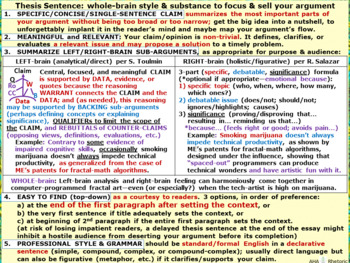Thesis Sentence: whole-brain style & substance to focus & sell your argument
- Gif
- Prezis
Description
This animated GIF highlights 5 essential factors of thesis sentence: Specific/concise, Meaningful, Summarize left- and/or right brain arguments, Easy to find (top-down), and Clear/professional style/grammar. Students will write clearer essays if they develop a habit-of-mind to consider all five of these factors in their thesis sentence. Image size 960×720 (file size 866 KB) for use as a full-size PowerPoint slide. Each of 7 frames lasts 6 seconds (if embedded in a PPT, it must be in Slide-Show mode to activate the looping animation); can also be resized as needed and used as a non-animated graphic in a handout about essay writing or persuasive communication or as a bell-ringer. Note: You can pause an animated GIF during a PowerPoint Slide Show by Right-Clicking your mouse; you can resume animation with a Left-Click. This mouse-trick works in PPT 2010, but other PPT versions may work differently. (frame #4 contains some fractal art examples related to the sample thesis sentence)
Used/tested and engaging with English Composition, English 101.
For a more in-depth treatment of the thesis sentence, see Thesis-Sentencing Guidelines.
To learn how to make such animated GIFs using PowerPoint and a free online AGIF maker, see PowerPoint slide show Animated GIFs—How to Make and Use.
For a more specific treatment of Stephen Toulmin's relevant ideas, see Toulmin Argument Model.


